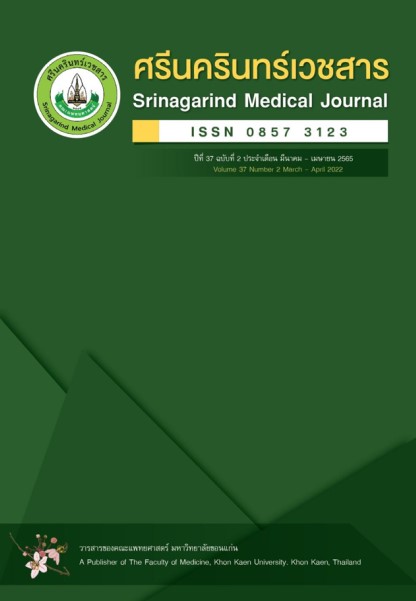The Effect of the Estimated Glomerulus Filtration Rate as a Trigger Tool Model to Prevent Vancomycin Induced Nephrotoxicity
Keywords:
vancomycin, vancomycin induced nephrotoxicity, Adverse drug reaction trigger toolAbstract
Background and Objective: Vancomycin is a broad-spectrum antimicrobial used intravenously for the treatment of Gram-positive pathogens, including Methicillin-resistant Staphylococcus aureus (MRSA) infection. Nephrotoxicity is a commonly feared and largely preventable adverse effect of vancomycin therapy. This study aimed to determine the effect of using estimated glomerular filtration rate (eGFR) as a Trigger tool to prevent vancomycin induced nephrotoxicity and to explore potential confounding factors that may increase the risk of nephrotoxicity in patients receiving vancomycin.
Methods: This study was a retrospective study. Data were compared before and after the trial of the eGFR trigger tool system in patients receiving intravenous vancomycin for at least 48 hours in the Central Chest Institute of Thailand with a period of 1 year, during October, 2017 to September, 2019 were included. Patients will be monitored until the drug is discontinued. The incidence of nephrotoxicity, defined as a decrease in eGFR by ≥25%, and/or an increase in serum creatinine (SCr) of 1.5-fold from its baseline value.
Results: The 336 hospitalized adults treated with intravenous vancomycin at least 48 hours in hospital during October, 2017 to September, 2019 were included. There were 157 patients in before using the eGFR trigger tool group and 179 patients in after using the eGFR trigger tool group. The present study found that the incidence of acute kidney injury before and after using a eGFR trigger tool were 34.4% and 19%, respectively (p = 0.002). Elderly patients (>70 yrs.), prolonged therapy of vancomycin (>14 days), concomitant treatment with nephrotoxic agents (gentamicin and colistin) and was also associated with an increased risk of nephrotoxicity (p = 0.012, p = 0.043, p = 0.044 and p = 0.048, respectively).
Conclusions: After initiation of the eGFR trigger tool, patients treated with vancomycin had a significantly lower incidence of acute renal failure than before using the eGFR trigger tool. Factors associated with vancomycin induced nephrotoxicity included patients older than 70 years, patients treated for more than 14 days, and concomitant exposure to other nephrotoxic drugs.
References
Kasmar AG, Hooper D. Pharmacology of bacterial infection: cell wall synthesis. In: Golan DE, Tashjian AH Jr, Armstrong EJ, Armstrong AW, editors. Principles of pharmacology: the pathophysiologic basis of drug therapy. 2nd ed. Baltimore: Lippincott Williams & Wilkins; 2008:601-18.
Mc Evoy GK. AHFS Drug Information 2005. Bethesda, American Society of Health-System Pharmacists 2005:467-71.
Liu C, Bayer A, Cosgrove SE, Daum RS, Fridkin SK, Gorwitz RJ, et al. Clinical Practice Guidelines by the Infectious Diseases Society of America for the Treatment of Methicillin-Resistant Staphylococcus aureus Infections in Adults and Children. Clinical Infectious Diseases 2011;52(3):e18-e55
Kett DH, Cano E, Quartin AA, Mangino JE, Zervos MJ, Peyrani P, et al. Implementation of guidelines for management of possible multidrug-resistant pneumonia in intensive care: an observational, multicentre cohort study. Lancet Infect Dis 2011;11(3):181-9.
Elyasi S, Khalili H, Dashti-Khavidaki S, Mohammadpour A. Vancomycin-induced nephrotoxicity: mechanism, incidence, risk factors and special populations. A literature review. Eur J Clin Pharmacol 2012;68(9):1243-55
Hanrahan TP, Kotapati C, Roberts MJ, Rowland J, Lipman J, Roberts JA, et al. Factors Associated with Vancomycin Nephrotoxicity in the Critically Ill. Anaesthesia and Intensive Care 2015;43(5):594-9
Rybak MJ, Albrecht LM, Boike SC, Chandrasekar PH. Nephrotoxicity of vancomycin, alone and with an aminoglycoside. J Antimicrob Chemother 1990;25(4):679-87.
Rybak M, Lomaestro B, Rotschafer JC, Moellering R, Jr., Craig W, Billeter M, et al. Therapeutic monitoring of vancomycin in adult patients: a consensus review of the American Society of Health-System Pharmacists, the Infectious Diseases Society of America, and the Society of Infectious Diseases Pharmacists. Am J Health Syst Pharm 2009;66(1):82-98
Winter ME. Basic clinical pharmacokinetics. Philadelphia: Wolters Kluwer/Lippincott Williams & Wilkins Health; 2010
Bagshaw SM, George C, Bellomo R. A comparison of the RIFLE and AKIN criteria for acute kidney injury in critically ill patients. Nephrol Dial Transplant 2008;23(5):1569-74.
Mehta RL, Kellum JA, Shah SV, Molitoris BA, Ronco C, Warnock DG, et al. Acute Kidney Injury Network: report of an initiative to improve outcomes in acute kidney injury. Crit Care 2007;11(2):R31
Kellum JA, Lameire N, Aspelin P, Barsoum RS, Burdmann EA, Goldstein SL, et al. Kidney disease: improving global outcomes (KDIGO) acute kidney injury work group. KDIGO Clinical Practice Guideline for Acute Kidney Injury 2012;2(1):1-138.
Downloads
Published
How to Cite
Issue
Section
License
Copyright (c) 2022 Srinagarind Medical Journal

This work is licensed under a Creative Commons Attribution-NonCommercial-NoDerivatives 4.0 International License.




